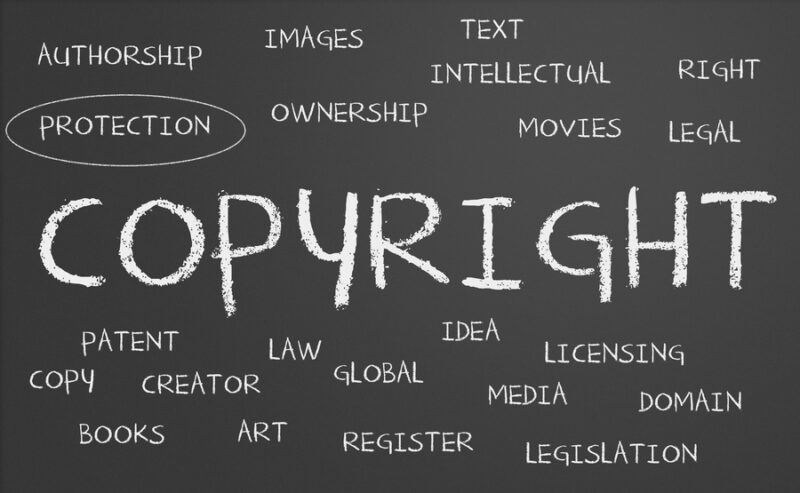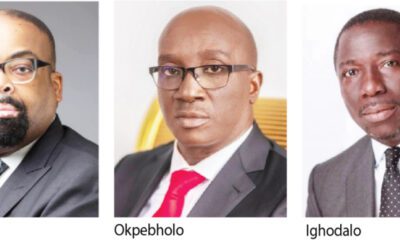Legal Issues
Analytical Discourse On Emerging Trends In Copyright Protection And Information Communication Technology -By Oyetola Muyiwa Atoyebi & Jamilu Samaila
Copyright is a property right that subsists in certain specified types of works as provided in the Act for the owner or creator of those specified subsists. The owner of the copyright subsisting in his work has the exclusive right to do certain acts in relation to the work such as making a copy, broadcasting, or selling copies to the public.

INTRODUCTION:
The 21st Century has been characterized by rapid advancement in Technology. Technology has become an intrinsic part of our daily life. The dynamicity of our laws has also moved with the speed of light to catch up with this advancement in technology by providing a regulatory framework to guide as well as protect the rights of individuals in the technological space. In a bid to protect these rights, several enactments such as; Copyright Laws, Cyber laws, together with other data protection laws of various countries have been put in place to guard against infringements. Despite these enactments, copyright protection and information communication technology are still riddled with some issues, pitfalls, and shortcomings.
Meaning of Copyright:
Copyright is the legal right given to an intellectual property owner. As the term suggests, it is the right to copy. Thus, it means that when a person creates a product, they own the right to it. So, only that individual can have the exclusive right to reproduce that work or anyone they give authorization to. Copyright laws grant the original creators of the product an exclusive right to use it further or duplicate the product for a specific time. At this point, the item that has been copyrighted develops into the public domain.[1]For instance, art, novels, computer software, films, website content, poetry, musical lyrics, and more are all unique creations. So, Copyright acts as a protection to legally safeguard that original creation. The Copyright law states that a work is original if the author made it by thinking independently, and not copying it from somewhere. If you have that copyright to your product, no one can use or replicate your work.[2]
Meaning of Information and Communication Technology (ICT)
On the other hand, Information and Communication Technology (ICT) is defined as a set of technological tools and resources used to transmit, store, create, share or exchange information. These technological tools and resources include computers, the internet (websites, blogs, and emails), live broadcasting technologies(radio, television, and webcasting), recorded broadcasting technologies (podcasting, audio, and video players, and storage devices), and telephony (fixed or mobile, satellite, Visio/video-conferencing, etc.)[3]
At this point, it is pertinent to note that the generally accepted international copyright and ICT law that each country is to abide by does not exist. Each country has its own domestic laws that specifically apply to it on a case-by-case basis. There are also laws that allow creators and content owners around the world and citizens of the countries to enjoy copyright protection in some other countries other than their own.[4]
Copyright Protection Laws and Information Communication Technology.
Copyright laws generally contain different provisions relating to computer programs and digital media copyrights, database, rental rights, cinema, literature-related rights, dramatic rights, musical rights, artistic rights, cinematograph rights, sound recordings rights, broadcasting rights, performer’s rights, phonograms rights, etc. It also provides a number of provisions for the use of protected works without seeking permission from authors for the purpose of fair dealings, such as private study, private use, research, criticisms, review, reporting current events in a newspaper, magazine, or similar periodical, in cinematograph films by broadcast or by the photograph.[5]
The laws also provide some other provisions to use a protected work without authorization from an author in cases of official gazettes, reports of various commissions, committees’ boards, or councils appointed by the government or other similar bodies, if it is not expressly prohibited to publish. Similarly, a number of other provisions also exist in law under which users are given powers to use freely the protected works in cases of sound recordings, cinematographic film, and computer programs under certain exceptional cases.[6]
Copyright is a property right that subsists in certain specified types of works as provided in the Act for the owner or creator of those specified subsists. The owner of the copyright subsisting in his work has the exclusive right to do certain acts in relation to the work such as making a copy, broadcasting, or selling copies to the public. These are examples of acts that are directly restricted by copyright. The owners of the copyright can control the exploitation of his work, for example by making or selling copies to the public or by granting permission to another to do this in return for a specified payment or not. If a person executes one of the acts restricted by the copyright act without the permission or license of the copyright owner, the latter can sue for infringement of his copyright and mandatorily can obtain remedies, for example, damages and an injunction under the Copyrights Act, 2004.[7]
Copyright laws provide a number of provisions for limitations. Limitation refers to terms of copyright. Copyright is not a perpetual property, unlike other movable or immovable properties. The ownership of copyright is limited to a fixed period of time, after the expiry of which copyright does not subsist and it becomes a public domain work, and then any person or individual can use it without observing any legal obligations. The term may differ from country to country.[8]
Emerging Issues of Copyright Protection and Information Communication Technology
The decentralized nature of the internet makes it possible for any user to disseminate a work endlessly in cyberspace through an end number of outlets, thereby giving rise to global piracy. Estimates of global losses from pirated books, music, and entertainment software range into billions of dollars. The internet in a way, presents a troublesome situation for copyright holders as the users become mass disseminators of other copyright materials and create disequilibrium between the authors and users. The advent of digital technology, therefore, presents legislators with a choice: either expand or modify existing ‘old media notions’ or redefine the catalogue of restricted acts, taking into account the peculiarities of the new environment in multiple facets discussed herein.[9]
The Right of Reproduction since the adoption of the Statute of Anne, the mother of modern copyright law, has been at the heart of copyright law for more than three hundred years. Though recognized as a seminal right accorded to authors, the Reproduction Right per se has not been unambiguously delimited by international instruments for copyright protection. Due to the lack of agreement on the right’s scope and content, the original text for the Berne Convention did not include any provision that expressly protected the Reproduction Right.[10]
Under Article 9(1) of the Berne Convention, copyright owners are granted “the exclusive right of authorizing the reproduction of these works, in any manner or form”. However, the ambivalence of Article 9(1) of the Berne Convention, particularly the phrase “in any manner or form”, has resulted in an international rift over the scope of the Reproduction Right.[11]
The advent of the internet makes the delimitation of the Reproduction Right more problematic in the digital age. Given that any transmission of protected works over the Internet involves the reproductions transitorily stored in the connected computers’ RAM. The question of whether owner’s rights should be granted control over all temporary reproductions, looms large amid the dematerialized and decentralized nature of the Internet.
By contrast, the World Intellectual Property Organization’s Performances and Phonograms Treaty of 1996 contain two articles (Articles 7 and 11) for the protection of the Reproduction Right enjoyed by Performers and Phonogram Producers respectively. Under the WPPT Performers and Phonogram Producers are vested with “the exclusive right of authorizing the direct or indirect reproduction of their respective protected subjects in any manner or form” (Agreed Statement concerning Articles 7, 11, and 16 of the WPPT). [12]The Agreed statements attached to the WCT and WPPT make it clear that Article 9 of the Berne Convention shall apply mutatis mutandis to the protection of the Reproduction Right in the digital environment. At first glance, what is clear under these two agreed statements is that permanent digital copies, for example, copies stored in floppy disks or a computer’s read-only memory (ROM), are protected by the WIPO Treaties 1996. Moreover, members are free to introduce new limitations or exceptions to the re-delimited Reproduction Right, subject to the three-step test. Yet the ordinary meaning of the second sentence of the agreed statements, in particular, the term “storage”, still remains largely ambiguous and obscure. Does it cover the making of temporary copies? One would answer in the negative that “in ordinary usage, ‘storage’ connotes a much higher level of activity than simple ‘temporary’ conduct”. [13]
On the contrary, a counter argument may simply imply that the temporarily stored copy does in fact constitute a form of storage of the work. Without a direct reference to the phrase “permanent or temporary”, the agreed statements, rather than fulfilling the proclaimed ambitious task to provide clarity, fail to determine the extent to which the reproduction right should be applied in the digital environment. The ambivalence of the treaty language leaves the question as to whether the temporary copies have been covered, potentially unsettled. The Right of Communication to the Public Digital technology blurs the line between different categories of copyrightable works and the means of communication to the public as well.
On the other hand, in the midst of fast development in digital technology, computer networks, in particular the internet, brings forth a point-to-point way of transmitting works on an on-demand and interactive basis. The interactivity and individuality afforded by this new method of exploiting works makes it possible for any member of the public to have full discretion in determining the place and the time one is intended to access and use works in digital form. Against this backdrop, a new form of unitary, technology-neutral right of communication to the public is suggested to be ushered in to replace the fragmentary, technology-specific protection of this right.
Paradoxically, it seems that the Berne Convention has become an incomplete and outdated international instrument for the protection of the right communication to the public, unable to respond to the challenges posed by the shift in the ways of exploiting works. First and foremost, the Berne Convention has lagged behind the trend in the digital conversions of telecommunications, media, and information technology. The right of communication to the public is regulated in a fragmented manner by the Berne Convention in terms of the means of communication. Second, the scope of the right of communication to the public does not cover all the Copyright Protection in the Digital Environment: Emerging Issues, and categories of copyrightable subject matter, including computer programs, photographic works, works of pictorial art, and graphic works. These works, however, have been and are being widely disseminated over the internet yet are vulnerable to unauthorized access and use.
Further to the above, it remains ambiguous under Berne Convention as to whether the traditional right of communication to the public would regulate the interactive, on-demand transmission of works over computer networks. Concern has been expressed that the Berne Convention may only be able to squarely regulate the point-to-multipoint communication of works, leaving right owners in the grey area where they probably do not have the right to exclude others from communicating their works to the public on a point-to-point basis with the interactive, on-demand nature. The perceived loopholes or ambiguities within the Berne Convention, therefore, make it evident that relevant obligations need to be clarified by providing a unitary, technologically neutral right of communication to the public.
After rigorous debate on the WIPO Diplomatic Conference 1996, a broad right of communication to the public was eventually established by the WIPO Treaties 1996. Article 8 of the WCT provides that: Without prejudice to the provisions of Articles 11(1) (ii),11bis (1)(i) and (ii), 11ter(1)(ii), 14(1)(ii) and 14bis(i) of the Berne Convention, authors of literary and artistic works shall enjoy the exclusive right of authorizing any communication to the public of their works, by wire or wireless means, including the making available to the public of their works in such a way that members of the public may access these works from a place and at a time individually chosen by them.[14] The WPPT contains two similar provisions (Articles 10 and 14) that accord performers and phonogram producers the right of making available to the public fixed performances and phonograms respectively. Under the WIPO Treaties 1996, two categories of the minimum standards for the protection of the right of communication to the public have been set up. First, regarding the point-to-multipoint communication routinely involving an active sender and passive recipients, they usher in a unitary right of communication to the public by wire or wireless means, technologically neutral in terms of copyrightable subject matter and means of communication as well.
This right fills up the lacunae existing in the Berne Convention and is designed to apply all copyrightable subject matter, including computer programs and databases that are not protected by the fragmented right of communication to the public under the Berne Convention. By supplementing the relevant provisions (e.g., Articles 11(1)(ii), 14(1)(ii), and 14(1)in the Berne Convention the new right of communication to the public is able to fully accommodate all communication of copyrighted subject matter that may be developed in the future.[15]
With respect to point-to-point communication routinely involving an active sender and an active recipient, the new right has been embedded into the general right of communication to the public. The main objectives to establish this new right are first “to make it clear that interactive on-demand acts of communication are within the scope of copyright protection”; and second “to harmonize the obligations” in order to “avoid any discrepancies that may be caused by different interpretations” of the traditional communication right under the Berne Convention. Excluding the physical distribution of works, fixed performances, and phonograms, the right of making available to the public specifically regulates interactive, on-demand online communication that is shiftable both in terms of place and time. Acts of communication subject to this new right, include those that enable members of the public to access protected subject matter from “a place and at a time individually chosen by them”. In this way, the control over the interactive means of exploiting copyrightable subject matter is conferred upon copyright owners under the rubric of the right of making it available. However, any other form of “exploitation by way of offering, at specified times, predetermined programs for reception by the general public”, falls outside the ambit of this new right. Although the WIPO Treaties 1996 significantly expand the scope of the right of communication to the public, the following two issues have been left unsettled. First and foremost, the term “the public”, has not been given a clear-cut definition in the context of the new right of communication to the public.
The Endeavour to delimit this term for the protection of the right of public performance has sparked much controversy just because technological developments in the digital dissemination of works carry the effect of blurring the public-private distinction. Given the increased difficulty to draw the line between private and public transmissions, it is understandable that the WIPO Treaties 1996 are silent on the benchmark with which the public-private distinction could be decided and leave the discretion to determine the scope of public communication to each contracting party. Moreover, the issue concerning the secondary liability of those who facilitate the infringing communication of works to the public, including Internet Service Providers (ISPs), has not yet been addressed.
Conclusion
Although the Copyright laws attempt to anticipate improvements in technology and scientific knowledge, the intended flexibility and broadness are hampered by the other eligibility requirements and parameters for copyright protection stipulated in the laws. New technological advancement has really exposed the lacunas of copyright protection in various jurisdictions. For instance, the narrow definition under the Act, of broadcast and communication to the public by a loudspeaker or any other similar device does not anticipate digital transmissions which are prevalent in today’s world.[16]
Also, the concept of fixation on a stable material or medium seems difficult to sustain as a pre-requisite for the qualification of creation as a copyrighted work, since intangibility and a transitory nature are common features of works placed on the internet. Social media and digital space in general is an avenue that promotes intellectual creativity and a minefield of ideas that can be deployed into important works. For any nation, including our own to progress economically, it must not play down the development of its intellectual resources. The only way to ensure the protection of original intellectual works is by tightening provisions for the safeguard of copyright products and especially, liberalizing provisions in the extant copyright laws of the country to be able to accommodate products derived from the rapidly growing technology in the world.[17]
SNIPPET
Copyright is a property right that subsists in certain specified types of works as provided in the Act for the owner or creator of those specified subsists. The owner of the copyright subsisting in his work has the exclusive right to do certain acts in relation to the work such as making a copy, broadcasting, or selling copies to the public.
Key terms:Copyright, copyright protection, protection of intangible and tangible assets
Author
Mr. Oyetola Muyiwa Atoyebi, SAN is the Managing Partner of O. M. Atoyebi, S.A.N & Partners (OMAPLEX Law Firm).
Mr. Atoyebi has expertise in and vast knowledge of Corporate Practice and this has seen him advise and represent his vast clientele in a myriad of high-level transactions. He holds the honour of being the youngest lawyer in Nigeria’s history to be conferred with the rank of Senior Advocate of Nigeria.
He can be reached at atoyebi@omaplex.com.ng
Contributor: Jamilu Samaila
Jamilu is a member of the Corporate Team at OMAPLEX Law Firm. He also holds commendable legal expertise in Copyright Law Practice
He can be reached at jamilu.samaila@omaplex.com.ng
[1]https://economictimes.indiatimes.com/definition/Copyright<accessed on 12th January 2023>
[2] ibid
[3]Ibid
[4]https://www.copyrightlaws.com/introduction-international-copyright-law/< accessed on 12/1/23>
[5]https://www.scirp.org/journal/paperinformation.aspx?paperid=77315< accessed on 15/1/23>
[6] ibid
[7] ibid
[8] ibid
[9]http://www.ijhssi.org/papers/v2(4)/version-3/B240615.pdf< accessed on 19/1/23>
[10] ibid
[11]https://www.cambridge.org/core/journals/international-journal-of-legal-information/article/abs/the-berne-convention-for-the-protection-of-literary-and-artistic-works-18861986-by-sam-ricketson-london-centre-for-commercial-law-studies-queen-mary-college-university-of-london-1987-pp-lxii-1030-uk10300/B440AF465DDE0A9C5A690D9C14744096<accessed on 21/1/23>
[12]https://digitalcommons.law.scu.edu/facpubs/541/< accessed on 22/1/23>
[13]https://people.ischool.berkeley.edu/~pam/courses/cyberlaw97/docs/wipo.pdf< accessed on 22/1/23>
[14] ibid
[15] ibid
[16]https://digitalcommons.unl.edu/cgi/viewcontent.cgi?article=13905&context=libphilprac< accessed on 12/1/23>
[17] ibid




















